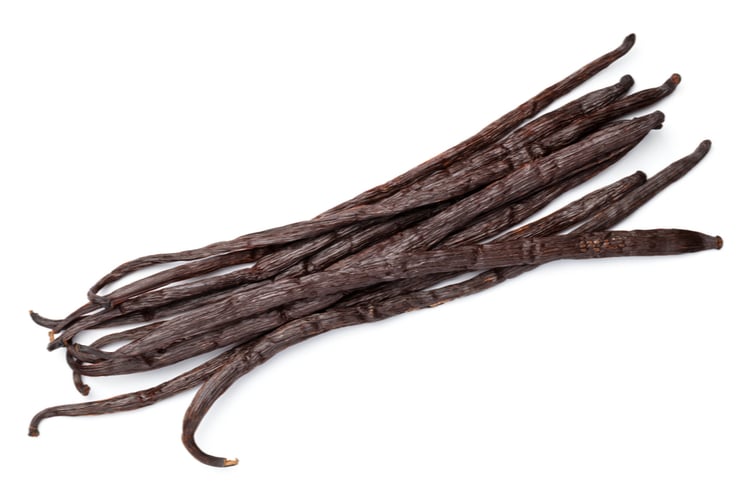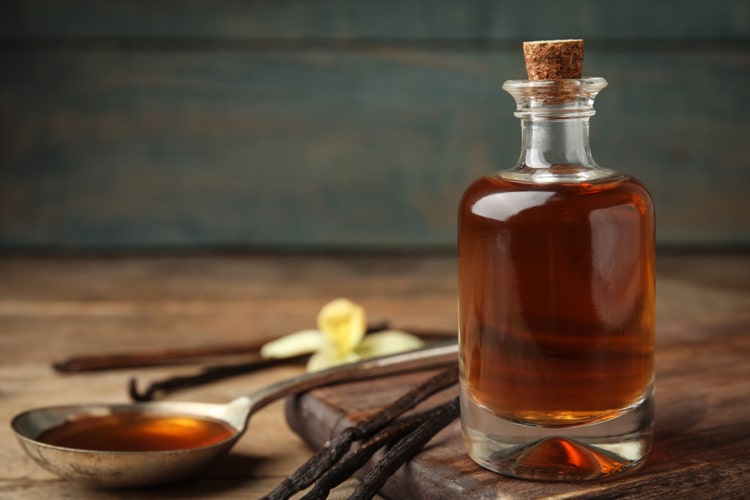Vanilla products are common ingredients in many sweet dishes. From cookies to ice cream, you’ll find this warm, delicious flavor in all types of desserts.
Not only does vanilla smell fantastic, but it adds an unmistakable taste to some of your most well-loved recipes.
If you’ve ever baked a cake or whipped up a batch of cookies, you’ve probably had to use vanilla extract. But have you ever been working your way through a recipe and found it called for vanilla bean?
Since it’s not a terribly common ingredient, you may not have it on hand.
However, you’ll likely have a bottle of vanilla extract stored away in your pantry. If that’s the case, you might be wondering whether your vanilla extract is a suitable substitute for vanilla bean.
The short answer is yes, you can substitute vanilla extract for vanilla bean. However, although both items can provide an aromatic vanilla flavor, they differ in quite a few ways.
Difference Between Vanilla Bean and Extract
The main difference between vanilla bean and vanilla extract is how the items are used. Vanilla beans come in long pods that you scrape the seeds from for use in recipes, whereas vanilla extract is a liquid made by soaking vanilla bean pods in alcohol to extract the flavor.
Appearance: Vanilla bean pods are long, thin, and reddish-brown. They’re filled with thousands of tiny vanilla beans that can be used whole or soaked to create an extract.
Conversely, vanilla extract is a dark reddish-brown liquid made from vanilla bean pods. Vanilla extract tastes bitter on its own and tastes sweet when added to other ingredients.
Flavor: Vanilla bean and vanilla extract both have a strong vanilla flavor; however, vanilla bean is far more intense than vanilla extract, which is usually diluted by alcohol and water.
Shelf Life: When stored properly in a cool, dry, and dark place, whole vanilla bean pods can last up to two years, while vanilla extract can last indefinitely.
However, since extract’s quality can decrease over time, you should use vanilla extract within five years for peak flavor. If your vanilla extract is greater than five years old, you will likely notice texture, color, and scent changes.
Use Cases: Vanilla bean is a good choice when you need a potent vanilla flavor and want the aesthetic benefit of beans in your recipe, such as ice cream or frosting. Vanilla extract is best for baking cookies, cakes, or bread where you may not want the beans to be visible and need a more subdued flavor.
Vanilla Bean vs Extract Comparison Table
| Vanilla Bean | Vanilla Extract | |
| Appearance | Long brown pods | Dark brown liquid |
| Flavor | Intense and aromatic | More subdued and aromatic |
| Shelf Life | 2 years | Indefinitely |
| Ratio | 1 pod | 3 teaspoons |
Can You Substitute Vanilla Bean for Vanilla Extract?
If you’re fresh out of vanilla beans or would rather not buy them, you can easily substitute vanilla extract for vanilla beans.
One vanilla bean pod equates to approximately 3 teaspoons of vanilla extract. 1 teaspoon of vanilla extract is roughly the equivalent of a 2-inch section of vanilla bean, so for a typical single batch of cookies or batter, you’d use 1-2 inches of a vanilla bean.
It’s important to note that these ratios apply strictly to vanilla extract. Imitation vanilla extract or vanilla flavoring isn’t an ideal substitute for either, although if you’re in a pinch, it’ll suffice.
In addition, if you make your own vanilla extract, you’ll probably need to make some ratio adjustments to account for your extract’s potency.
What is Vanilla Bean?

Vanilla beans are the product of vanilla orchids, which grow naturally in the tropical regions of Central America. The Aztec people of Mexico began cultivating the vanilla orchid in the 15th century.
When the Spanish came to the New World, Hernán Cortés saw the benefit of such a flavorful and aromatic flower, so he brought some back to Europe in the 16th century.
Although Mexico was initially the world’s largest supplier of vanilla, that changed in the latter part of the 19th century. In the mid-1800s, the French shipped vanilla orchids to Seychelles, Madagascar, and the Comoros Islands for hand-pollination that could facilitate mass production.
By the start of the 20th century, those three areas produced about 80% of the world’s vanilla.
In the wild, vanilla orchids grow on vines that grow around trees. However, vanilla producers use other forms of support for their vines, such as trellises or poles, if they’re producing it on a plantation or in a greenhouse.
It takes about 2-3 years for the plant to grow to the appropriate point for harvesting. The lengthy growth process and small yield are why vanilla beans tend to be so expensive and why extract is often the preferred substitute for beans.
After the vanilla orchid is harvested, the green pods, or fruit, shrivel up and turn dark. A typical harvested vanilla bean pod is blackish-brown with hints of red and a waxy feel.
The pods are filled with thousands of tiny vanilla beans no bigger than the size of specks.
How to Use Vanilla Bean
One of the best things about vanilla beans is that you can use them whole by either scraping the seed or soaking the entire pod. Which method you choose will depend on what recipe you’re using.
The easiest way to extract vanilla beans from a pod is to gently slice the pod open using a paring knife. Then, simply scrape the inner flesh of the pod with the edge of your knife to remove the beans.
They’ll stick together at first due to the plant’s moisture content, but you can leave them to dry or simply mix them into your recipe to separate.
Once you have your beans, they’ll be ready to use in your recipe right away. For example, you can mix them into your batter, frosting, or cream to make a sweet, aromatic dessert.
The beans are very tiny, so you won’t have to worry about grinding them down unless you need a fine powder.
If you’ve used vanilla beans in recipes before and want to try something new, you can make vanilla sugar. It’s a simple recipe and is an excellent substitute for sugar in baked goods and coffee.
The best way to make vanilla sugar is to combine the beans and sugar in a food processor. Then, you can use it immediately or let it sit to absorb more flavor.
What is Vanilla Extract?

Vanilla extract is the liquid that results from macerating or soaking vanilla pods in alcohol. It’s the most popular method of incorporating vanilla into recipes.
Extract is easy to access, less costly than vanilla bean, and has a longer shelf life than whole vanilla pods. Most commercial extract consists of a mix of alcohol and water, but homemade extract will vary.
The United States Food & Drug Administration has strict regulations extract manufacturers need to meet for their product to be classified as real vanilla extract. For example, in the US, all vanilla extract must contain 35% alcohol and 100 grams of vanilla bean for every liter.
You can also purchase double or triple strength vanilla extract, but it’s not widely available and is mainly used in the foodservice industry.
Due to the fluctuating price of vanilla beans over the years, companies have started to produce imitation vanilla products as a low-cost replacement for pure extract.
You’ll find imitation vanilla extract or vanilla flavoring in inexpensive products that have a strong vanilla flavor, such as store-bought cookies or sweets.
Lab-created vanillin, the chemical compound in vanilla beans that give them their flavor, is what provides the vanilla taste and aroma of imitation extract. The synthetic vanillin in imitation extract can come from several sources, but it’s most often a product of refined petrochemicals.
How to Use Vanilla Extract
Vanilla extract is pretty straightforward to use. It comes in a small bottle, usually only a few ounces, and a little goes a long way.
A standard at-home cake batter or cookie dough won’t need more than one or two teaspoons of extract to achieve your desired vanilla flavor.
However, if you’ve made or plan to make your own homemade vanilla extract from vanilla beans, you may need to make adjustments to how much extract you use in your recipes. This is because different beans provide different flavors and come in different grades.
In addition, you’ll also likely use vodka as your liquid instead of the standard ethanol and water. You can either use full-strength vodka or dilute it with a bit of water, which will further affect the flavor. And, as with vanilla beans, vodka comes in varying qualities.
So, if you plan to make your own vanilla extract, expect to go through a trial-and-error period before you find your best ratio.






